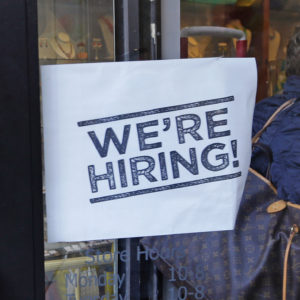The U.S. economy continued its sluggish but positive recovery by adding an additional 156,000 new jobs during the month of September, according to a federal report Friday.
The Bureau of Labor Statistics (BLS) releases a report every month which tracks employment growth. The economy has improved greatly since the last recession almost a decade ago but at a very slow rate. The labor market has gained an average of 178,000 new jobs a month this year.
“Total nonfarm payroll employment increased by 156,000 in September,” the report stated. “The unemployment rate, at 5.0 percent, and the number of unemployed persons, at 7.9 million, changed little in September. Both measures have shown little movement, on net, since August of last year.”
The economy is in a relatively good position when it comes to employment growth. The labor market has even managed to reach close to full employment. Nevertheless, other market indicators are showing very troubling signs. The labor force participation rate, for instance, has failed to reach the level it was at before the recession.
“It’s been slow but steady,” First Trust Advisors Economist Strider Elass told InsideSources. “We call this the plow-horse economy because that’s exactly what it is. It’s a slow but steady recovery that we’ve been seeing, and we’ve seen the same thing with employment.”
The labor participation rate tracks the number of employed and those actively seeking work as a percentage of the total population. The participation rate factors in those who have suffered long-term joblessness, unlike the unemployment rate.
“The labor force participation rate has been falling for eight years,” Notre Dame Professor Barry Keating told InsideSources. “We’ve never seen a situation where the participation rate has fallen by as much as it has, and we’ve never been in a situation where the recovery has been as slow as it has.”
The labor force participation rate has shown a slight improvement over the last few months. Nevertheless, it has failed to even get close to where it was before the recession. The recession, young people staying in school longer and baby boomers retiring are likely all playing a role in it being so low. The Gross Domestic Product (GDP) has also shown troubling signs. GDP growth has sat at roughly one percent over the past several months.
“Over the long hall we’d like to be at about three percent growth,” Keating said. “That takes into account the fact that the population is growing and we have immigration and we all would like to be doing a little bit better off ten years from now than we’re doing right now.”
President Barack Obama has overseen the recovery throughout his entire administration. The recession was sparked by the subprime mortgage crisis and the financial crisis of 2007. HR Policy Association Chief Economist Mark Wilson notes the labor market is actually where is should be.
“It’s been pretty good in terms of the employment growth, actually very good,” Wilson told InsideSources. “This year, the average monthly increase in payroll jobs has been 182,000 and that’s pretty good.”
Wilson adds there a few factors that have made some feel the labor market is not where is should be. He notes that the slow start to the recovery and misleading political rhetoric has all fed into the misconception. He adds that the labor market must be looked at in an objective and thorough way.
“Job growth in this particular recovery was initially slow and to be expected given the severity of the recession,” Wilson said. “That impacted people’s perception of the job market, plus the first three years of the recovery, wage growth was very poor.”
Nevertheless, others see government policies as holding back what could be robust growth. Elass notes the recession and recovery were met with an expansion of government that has held back the private-sector from really growing the economy at the rate it should be at.
“Government during the recession and after has just gotten so big as a share of the economy,” Elass said. “We’ve had very bad policies put in place that have been really detrimental for the entrepreneur. If you want faster growth you need to shrink the size of government and that’s just something we haven’t seen much of over this recovery.”
Professional and business services saw the most significant increase of new jobs at 67,000 followed by healthcare and food services. Mining employment numbers finally stopped dropping and remained unchanged in September. Mining has decreased by 220,000 jobs since reaching its peak in September 2014.
Average wages increased by six cents and now sit at $25.79 for the month of September. Wages in recent months have shown slow but positive growth. The jobs report does not include farm workers, private household employees or nonprofits.

